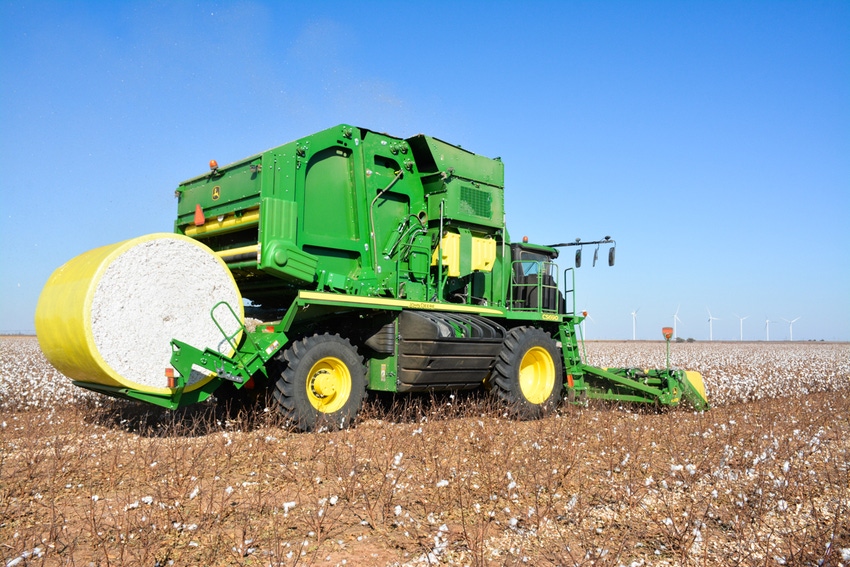
A 2018 report by the USDA Cotton & Tobacco (C&T) Program revealed that 40% of the nation's plastic-contaminated cotton comes from the Corpus Christi, Texas, classing office – a distinction that's motivated Jeff Nunley, executive director of South Texas Cotton and Grain Association (STCGA), not only to address the issue but, as an association, investigate how it can be reduced.
 (Jeff Nunley, executive director of South Texas Cotton and Grain Association. Photo by April Nunley.)
(Jeff Nunley, executive director of South Texas Cotton and Grain Association. Photo by April Nunley.)

"The Corpus office stands out like a sore thumb and that's not a distinction you want as a region," Nunley said during the Plastics in Cotton webinar, May 6. Since then, he's using every opportunity to raise awareness about the issue; whether at gin annual meetings or crop tours, he's talking about it.
There are 10 regional cotton classing offices across the Cotton Belt, four in Texas.
Because cotton gins handle all of the cotton classed, Nunley, with the help of Tony Williams, executive vice president, Texas Cotton Ginners Association, developed a survey to help identify issues that may be contributing to their contamination issues. The survey was given to each gin within STCGA's 33-county service area, from the upper and lower Coastal Bend into the Winter Garden region.
See, Plastic contamination increases in 2019; Norman says prevention is key
"It was different than what you think of with normal surveys," Nunley said. "I didn't ask quantitative questions; rather, they were more qualitative questions."
Though he didn't ask the gins for data, he said several provided it. "It's amazing some of the data gins collect.
"Our goal was to see if we could identify some common problems, identify practices that work or don't work, get ideas for different approaches for producers and then come up with some best management practices," he said.
Of the 26 surveys e-mailed, about 30% of the gins responded, which represented 654,000 bales. "It was a good representation of bales," Nunley said. "Not so much in terms of gins, but there was diversity. I had one of the best gins in the area, one plastic bale per 5,600 bales ginned, and one of the worst gins, which had one plastic bale per 400 bales ginned."
After removing the best and worst gins, Nunley calculated an Olympic average of the remainder, which was one plastic bale per 2,100 bales ginned.
Module wrap contributed to most of the contamination issues, "which we would expect," Nunley said. "The yellows, pinks, and maybe some experimentals of the blues and greens."
After reviewing the responses and determining common issues, Nunley identified three areas that need to be addressed: producer issues, transport issues, and cotton gin issues.
Producer issues
The number one complaint from gins is oversized modules, Nunley said. "Oversized modules don't fit on the module truck, and they get deformed sitting in the yard if they sit for a while. They're just harder to handle."
One ginner mentioned finding plastic tags in the module. "He suspected it was from when those machines change rolls during harvest, sometimes it would pull a tag into the module. He suspected it was from older machines working in that area. It could have been an issue with wear or a setting or operator error."
See, Plastic contamination: Who bears the cost?
Broken modules also are problematic. "As far as handling those modules in the field, most of the ginners will tell you broken modules are a big problem."
Module placement is another issue mentioned, along with litter in the fields and field margins.
Transport issues
Transporting busted modules from the field to the gin is difficult. "Handling busted modules, whether you're a producer or a ginner, is a pain. And those oversized modules likely become busted or damaged if they won't fit on a module truck," Nunley said.
Gin issues
How a gin unwraps a module varies widely and can contribute to cotton contamination. While some gins use the most expensive and automated machines to remove the plastic, Nunley said many said they went back to using a front loader because they thought it was "more effective and might reduce their plastic problem."
Very few of the gins surveyed, including the ones Nunley considers to be some of the better gins in the area, use a camera or light at the module feeder.
"Some gins are separating their broken modules and setting those where they can gin them as a batch, where it makes it easier to manage the plastic. They do that with a day crew and handle them at one time."
One of the survey questions asked whether the gin had viewed the National Cotton Council video, "Prevention of Plastics Contamination." Disappointingly, very few said they had, Nunley added.
"The video NCC put together is great information on how to mitigate plastic contamination and it's not being used by most gins. That's one of the things that would be helpful."
Overall, Nunley said several contamination issues, "should be relatively easy to address and could make a difference," without adding a tremendous amount of cost.
For example, adding a camera and lights to the module feeder is relatively inexpensive. "We had a ginner at a meeting from the Southeast who said a $200 camera in the module feeder did more for his gin to reduce plastic than any other measures. So, that's something to consider."
Nunley said they'll start with the simple issues and solve those first and then begin to tackle the harder issues to make a difference in plastic contamination. "We can't afford the reputation and my biggest concern is that we become recognized as an area that has a problem with plastic contamination and that affects our ability to market cotton which affects us all."
The Plastics in Cotton webinar was hosted by the Texas A&M AgriLife Extension offices and their crop committees in Nueces and San Patricio counties.
About the Author(s)
You May Also Like






